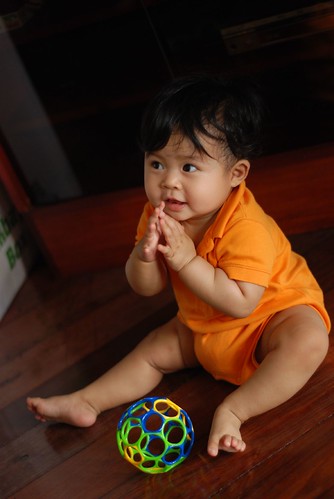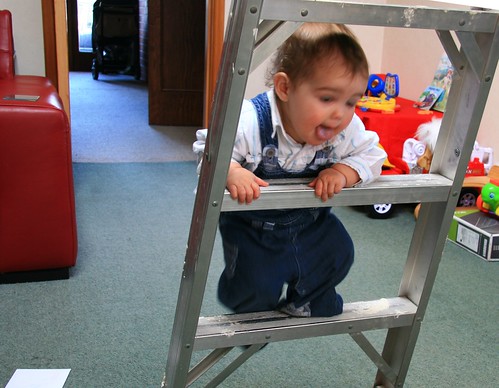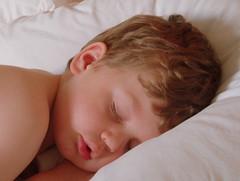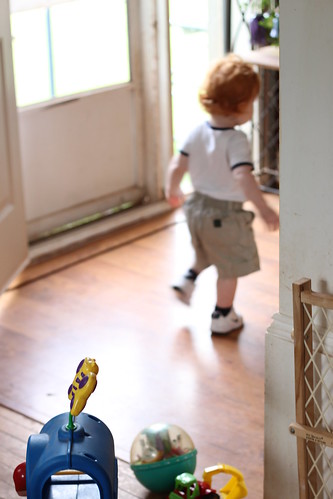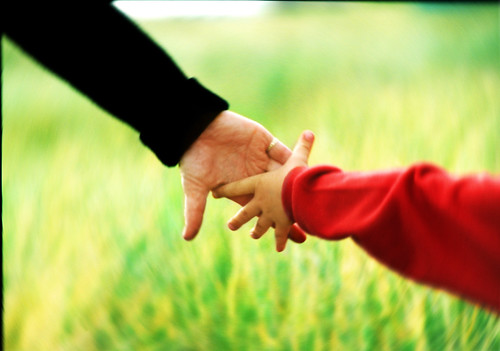Update: The eighth post in a series of ten on effective gentle discipline methods. This was one of my favorite posts to write.
“Life’s disappointments are harder to take when you don’t know any swear words.” -Calvin & Hobbes
We’ve been having thunder storms here for days now. It thunders. There is lightening, and then it pours rain. Afterwards, the sky clears, the air is cool and fresh, and all is well again. Sometimes this process goes on for weeks, until we are back to fair skies.
Temper tantrums are much the same as thunder storms. Think of temper tantrums as emotional weather. They can be loud and scary, but in the end, the air is clear, and skies are sunny again.
Each child is unique, but I’ve never known one who went through toddlerhood without at least one good tantrum. Why are children prone to tantrums at times? There are many reasons. Young children are small, but often have big feelings, and ideas which they can’t always express or carry out easily. Their daily schedules and activities are decided upon by the adults who care for them. They are learning and growing daily, but they can become easily overstimulated and overwhelmed. When too much pressure builds up they may blow up!
If your child is well nourished and well rested, gets outdoors and plays actively each day, has a predictable daily routine, has plenty of opportunities to participate in her own care, and you are communicating clearly and respectfully, allowing for tarry time, and monitoring your home environment to make changes as needed, chances are temper tantrums will be few and far between.
Here is one of my favorite stories about S. who will turn three in just another few weeks, and occasionally succumbs to whining, which is a whole other beast! As long as I’ve mentioned whining, I might as well go ahead and say that while temper tantrums are common at one and two, whining is more common at three and four.
With an older child, whose verbal skills are well developed, it helps to have a zero tolerance policy towards the whining. When S. whines, her parents and I calmly explain that we don’t like her tone of voice, and find it hard to understand or listen to her when she talks in that tone. Then we ask her to repeat herself in her “regular” voice. We reassure her that she is much more likely to gain our help, and understanding if she just talks to us without whining. This works.
But it does no good at all (and may make matters worse) to tell a one or two year old to “use your words”, especially in stressful situations. I’ve always loved what Magda Gerber had to say about this topic: “If they COULD use their words, they would.” Have you as an adult (who no doubt has a LOT of words and is very capable of using them) ever become so overwhelmed by a situation or an emotion, that all you could do was cry, or scream? I know I certainly have. OK then. Let’s move on.
If a toddler isn’t using her words, it’s because the situation is too stressful, she doesn’t have the words to express her feelings, needs or desires, or she feels “unheard” in a situation, and is ACTING in a way that she knows everyone will pay attention to. Smart child.

OK, so back to S. and her temper tantrum. S. was just a little over two years old, and had received an easel and watercolors for her birthday. S. loved to paint morning, noon, and night. Her parents, well meaning and caring adults that they are, thought it would be a great idea to enroll S. in a class, where she could interact with other two year old children and paint to her heart’s content.
Honestly, it was this low key little class, where parents or caregivers stayed with their child, and for the first hour, the children could paint, work with clay, or spread glitter glue all over paper. There was no formal instruction, no emphasis on creating a finished product, no model to follow, nothing.
The second hour, kids could choose to help make cookies, or play outside on the little playground, and an older lady (a grandmother) strummed the guitar and sang popular kid songs. Most of the children would sing and dance along, and the whole morning ended with warm, fresh baked cookies, and organic juice.
Sounds ideal right ? Except S. didn’t think so. She would much rather paint with me at home. The other difficulty was that this class started at 9:30 am, and I arrived at S.’s home at 9:00 am, so there was a little bit of a rushed atmosphere in the morning, as her parents would quickly give me a morning report, and I’d steer S. towards the door so we could get to class on time.
One particular day, S. was determined to paint at home, before class. Her parents and I were chattering above her while she readied her paint supplies, and kept repeating that she wanted to paint, “right now, please.” We told her what fun she’d have painting at class, and continued our exchange of information and preparations to leave.
Suddenly, S. said (in a very loud voice and while stamping her feet) I. WANT.TO. PAINT. RIGHT. NOW. We all stopped, and stared at each other in astonishment. S. hadn’t ever had a tantrum before. Then S., looking a little sheepish, said, “Where did that big voice come from?” and promptly burst into tears. Where indeed?
Sometimes, a temper tantrum can alert parents and caregivers to the fact that they need to slow down, and really see, and listen to a child. S. wanted to paint. At two years old, she didn’t want or need an art class- no matter how “ideal” it was. It wasn’t ideal for her at that time. The class was abandoned, and S. painted happily ever after- at home.
Prevention is best, but sometimes things get out of balance, and a child’s loss of temper alerts us to the fact that they need more connection. So if your child is having frequent tantrums, it might be a good time to ask yourself if things are a little out of balance or there are areas in your child’s life that need adjusting.
What can you do to support your child in the moment when she’s experiencing a storm of emotions? Make sure she’s in a safe place. Just stop. Hold a space. Don’t try to console or distract her. Let her go all the way through the tantrum to the end. Stay nearby. If your child wants hugs and cuddling after a tantrum, by all means offer them. Otherwise, a few comforting words can help. “You were very upset. I heard you yelling loudly, and saw you kicking the pillows. Do you feel better now?” It’s usually not necessary to say or do much more. (If you are in a public place when a tantrum starts- leave. Get your child to the car, and follow the above steps.)
It is never acceptable for a child to hurt others, including you, no matter how angry she is. If she is hitting, kicking, or biting you, first put her down if you are holding her, and tell her in a calm, firm voice, “I understand you are upset, but I won’t let you hurt yourself, or anyone else. If you want to kick/hit/bite, here is a doll/pillow/toy, that you may use.” Then move away.
The less emotion YOU show, and the more calm acceptance you can muster, the more quickly temper tantrums will dissolve and cease to exist all together. It’s normal and natural for your toddler to have an occasional tantrum, but sometimes parents become so upset or distraught when a child has a tantrum, they will go to any lengths to try to stop it. This gives the child a message that a tantrum is a good way to get a reaction from Mom or Dad, and possibly a way to get things her own way in the future.You don’t want to give your child the idea that temper tantrums are a good way to get you to cave in to every whim and demand, or that she needs to have a tantrum to get your attention anytime he’s upset.
By the way, no normally developing, healthy child I have known, or heard about, has EVER seriously injured herself during a tantrum. So if you are tying yourself in knots trying to appease your toddler for fear that she is going to literally stop breathing, bash her head in, or claw her eyes out- you need not worry.
When your child is mastering a new physical skill like walking, she tries and fails many times. She lurches forward, falls down, and gets back up again. Learning emotional control and maturity is no different. She’ll try, fail, possibly have a temper tantrum, and move on. It’s all a part of growing up!


